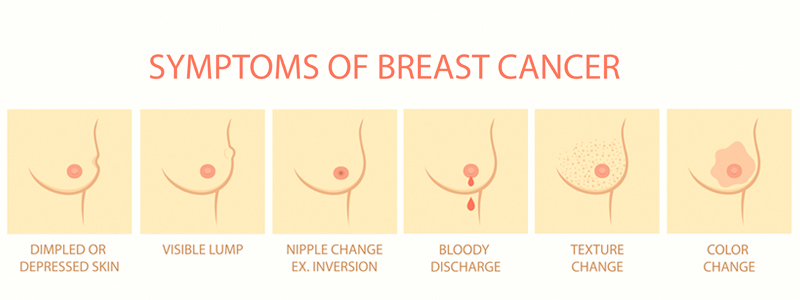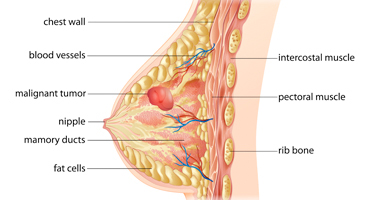Breast Cancer Surgery

Breast cancer is the second-most-common cancer, and the second-leading cause of cancer deaths, among women. Most breast cancers are slow-growing, but there are types that are aggressive, which is why early detection is essential. Breast cancer is defined by the type of breast cells in which it begins, and is generally categorized as invasive or noninvasive. Breast cancer can also affect men, but it is 100 times more common in women.
Types of Breast Cancer
Two types of cancer that occur rarely are inflammatory breast disease, in which cancerous cells block the lymph vessels within the breast, and Paget disease of the nipple, in which the cells in or around the nipple become cancerous. They account for, respectively, approximately one to six percent, and approximately one percent, of breast cancers. The two most common types of breast cancer are ductal carcinoma and lobular carcinoma.
Ductal Carcinoma
This is the most prevalent type of breast cancer, and it begins in the cells that line the milk ducts. More than half of breast cancer cases diagnosed each year are of this type. There are two kinds of ductal carcinoma:
Ductal carcinoma in situ (DCIS)
With DCIS, cancer cells are found only in the milk-duct lining, and have not spread to other breast tissue. DCIS is often discovered when a mammogram is done as part of a regular screening. In recent years, the number of DCIS diagnoses has increased dramatically, primarily because the number of screening mammograms has increased. DCIS isn't life-threatening, but requires treatment to make sure the cancer does not spread.
Invasive ductal carcinoma (IDC)
With IDC, cancer cells have spread from the ducts to other parts of the breast tissue. This is the most common type of invasive breast cancer, requiring treatment at an early stage to make sure it does not spread from the breast tissue to other parts of the body. It accounts for approximately 65 to 85 percent of invasive-type breast cancer cases.
Lobular Carcinoma
Lobular carcinoma begins in the breast's milk-producing glands, which are called lobules. The breast contains 15 to 20 lobes; the lobules are the smaller lobes within them. There are two types of lobular carcinoma:
Lobular carcinoma in situ (LCIS)
With LCIS, abnormal (rather than cancerous) cells are found only in the breast lobules; they do not spread to other tissue. LCIS is asymptomatic, and usually does not show up on mammograms. It is often discovered when a biopsy is performed for another reason.
Invasive lobular carcinoma (ILC)
With ILC, cancer cells spread from the lobules to close-by breast tissue. It requires treatment at an early stage to make sure it does not spread from the breast to other parts of the body. It accounts for approximately 10 to 15 percent of invasive-type breast cancer cases.
Risk Factors for Breast Cancer
The greatest risk factor for developing breast cancer is being female, probably because men produce much less estrogen and progesterone, hormones that can promote the growth of malignant breast cells. Other risk factors for women may include:
- Being 55 years of age or older
- Carrying a BRCA1 or BRCA2 gene mutation
- Having a family history of breast cancer
- Having been diagnosed with breast cancer before
- Having dense breast tissue
- Having certain benign breast conditions
- Using, or having used, hormone therapy

Signs or Symptoms of Breast Cancer
Women are advised to perform a breast self-exam once a month to check for changes or abnormalities, which may include:
- A lump in the armpit that does not go away after a menstrual cycle
- Swelling in the armpit
- Pain or tenderness in the breast
- A change in the size, contour, texture or temperature of the breast
- A change in the nipple
- An unusual discharge from the nipple
- A flattening or indentation in the breast
Diagnosis of Breast Cancer

Most testing for breast cancer begins when a woman or her doctor finds an abnormality in the breast through a physical exam, or when a routine mammogram picks up an abnormality.
Tests that may be performed to diagnose breast cancer include:
- Diagnostic mammogram
- Ultrasound
- MRI scan
- Fine-needle-aspiration biopsy
- Core needle biopsy
- Surgical biopsy
- Ductogram
- Sentinel-node (lymph-node) biopsy
Treatment for Breast Cancer
The type of breast cancer treatment recommended depends on the size of the primary tumor and its location, whether the cancer has spread to the lymph nodes or to other parts of the body, and whether the tumor has estrogen or progesterone receptors. Tumors with these receptors require estrogen and/or progesterone to grow, and usually respond well to hormone therapy. Surgical treatments for breast cancer usually include those below.
Lumpectomy and Partial Mastectomy
These are designed to save the breast by removing only the cancer and a small margin of surrounding tissue. Lymph nodes under the arm may also be removed to check to see that the cancer has not spread.
Total Mastectomy and Modified Radical Mastectomy
These are procedures that remove the entire breast. A total mastectomy, in addition to removing the breast, removes many lymph nodes under the arm, the lining over the chest muscle, and, possibly, the chest muscle itself.
Other treatment options that may be used alone or with surgery include chemotherapy, radiation therapy and targeted drug therapy.
Although there is no way to prevent breast cancer, early detection increases the odds of a successful treatment outcome. Screening mammograms are recommended, but there is some dispute about the age at which women should start getting them, and how frequently. One recommendation calls for yearly exams once a woman turns 40 years old; another specifies biannual exams for women between 50 and 74 years old. A woman should check with her doctor to determine her best course of action.
Breast-Conservation Surgery

Unlike mastectomy, in which the entire breast is removed, breast-conservation surgery saves as much of the breast as possible by removing only cancerous tissue and a small margin of healthy tissue. The advantage of this type of surgery, which is also referred to as partial, or segmental, surgery, is that most of the breast remains intact, reducing the need for reconstruction.
Whether breast-conservation surgery is possible depends on the size of the tumor, and whether the cancer has spread to nearby tissue or lymph nodes, or other parts of the body. If post-surgery radiation therapy will be part of the treatment, small metallic clips that show up on X-rays may be placed inside the breast during surgery to mark the area that will receive the radiation.
Types of Breast-Conservation Surgery
There are two basic types of breast-conservation surgery:
Lumpectomy
A lumpectomy removes the breast lump and a surrounding margin of healthy tissue. Radiation therapy is usually given after a lumpectomy. If chemotherapy is also part of the treatment, it is usually done before the radiation therapy.
Quandrantectomy
A quandrantectomy removes more breast tissue than a lumpectomy does, with one-quarter of the breast being removed. Post-surgery radiation therapy is usually given, but may be delayed if chemotherapy is part of the treatment.
Lymph nodes from the underarm area are often removed during surgery to check for the presence of cancer. In general, breast-conservation surgery is only recommended for women with small and/or localized cancers.
Our Surgeons Specializing in Breast Conditions

- Allen Agapay, MD
- General Surgeon
- Peoria
- Learn More

- Nathan Bodily, MD
- General Surgeon
- Gilbert & Mesa
- Learn More

- Rita Hadley, MD, FACS, PhD
- General & Bariatric Surgeon
- Mesa
- Learn More

- Theodore Haley, MD, FACS
- General Surgeon
- Gilbert
- Learn More

- Charles Castillo, MD, FACS
- General Surgeon
- Central Phoenix
- Learn More

- Susan Cortesi, MD, FACS
- General Surgeon
- Mesa & Scottsdale
- Learn More

- Jon King, MD, FACS
- General Surgeon
- West Phoenix
- Learn More

- Daveshni Kumar, MD, FACS
- General Surgeon
- Mesa & Scottsdale
- Learn More

- Matthew Marini, MD, FACS
- General Surgeon
- Gilbert & Mesa
- Learn More

- Kevin Masur, MD, FACS
- General Surgeon
- Mesa & Scottsdale
- Learn More

- Mark Runfola, MD, FACS
- Surgical Oncology
- Mesa
- Learn More

- David Smith, MD, FACS
- General Surgeon
- West Phoenix
- Learn More

